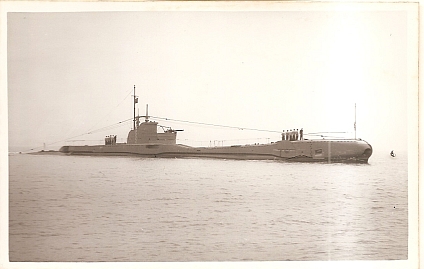Submarine museums
Submarine museumsThere are 92 complete submarines on display around the world (plus a few dozen more sails, conning towers, periscopes and other parts). Here are details of a dozen of them....
Portsmouth UK - HMS Alliance (1947) at the Submarine Museum, Gosport, Hampshire. Alliance is about 1,600 tonnes dived, so only 5% larger than HMS Triumph. In reality, Alliance and her Amphion class sisters were basically T-boats with a slightly changed arrangement of torpedo tubes, slightly larger fuel tanks and better aircon. One way of making room for these was to put the CO's cabin inside the fin, on its own small deck above the control room. This added about a quarter of her extra size.
Another was the removal of the two escape chambers (fore and aft) which experience showed were not much practical use (there is not a single record of anyone actually using one to survice a sinking). Removing these gave about fifteen feet of useable space.
The third change was to round out the pressure hull at her bow and stern (Triumph's was slightly oval). This added another 20 tonnes of displacement, but also increased her maximum diving depth by a few hundred feet as a round hull can withstand more pressure than an ovoid hull.
Apart from these small changes, Alliance is basically identical to a "T", and a visit to her gives an almost perfect idea of what life in Triumph was like.
Here are some photos of Alliance...
Alliance seen from aft. Her hull is almost identical to Triumph, though the fin is larger and more streamlined. She has also had her gun removed.

Alliance's interior is almost identical to Triumph. This is the torpedo stowage compartment, with a Folboat stowed in one of the torpedo racks.

The Junior Rates mess. Leather has given way to fabric seat and bunk coverings. Alliance carried out a record dived snort transit after the war, crossing the Atlantic in 30 days. She shipped a movie projector for the first time, to combat boredom.

Alliance has two JR messes - the stokers use to mess abaft the machinery space, but they were moved forrard next to the Seamen's mess in order to get their mess away from the heat of the main engines, and therefore cooler in tropical waters. This one is more familiar as a T-boat mess.

Alliance's Petty Officers' mess:

The Artificers and Chiefs' mess:

Alliance's wardroom. Compare this with the Tribune photos. The space is the same but again leather has given way to chintz.
The ladder just visible on the right hand side of the picture is the gun tower ladder.
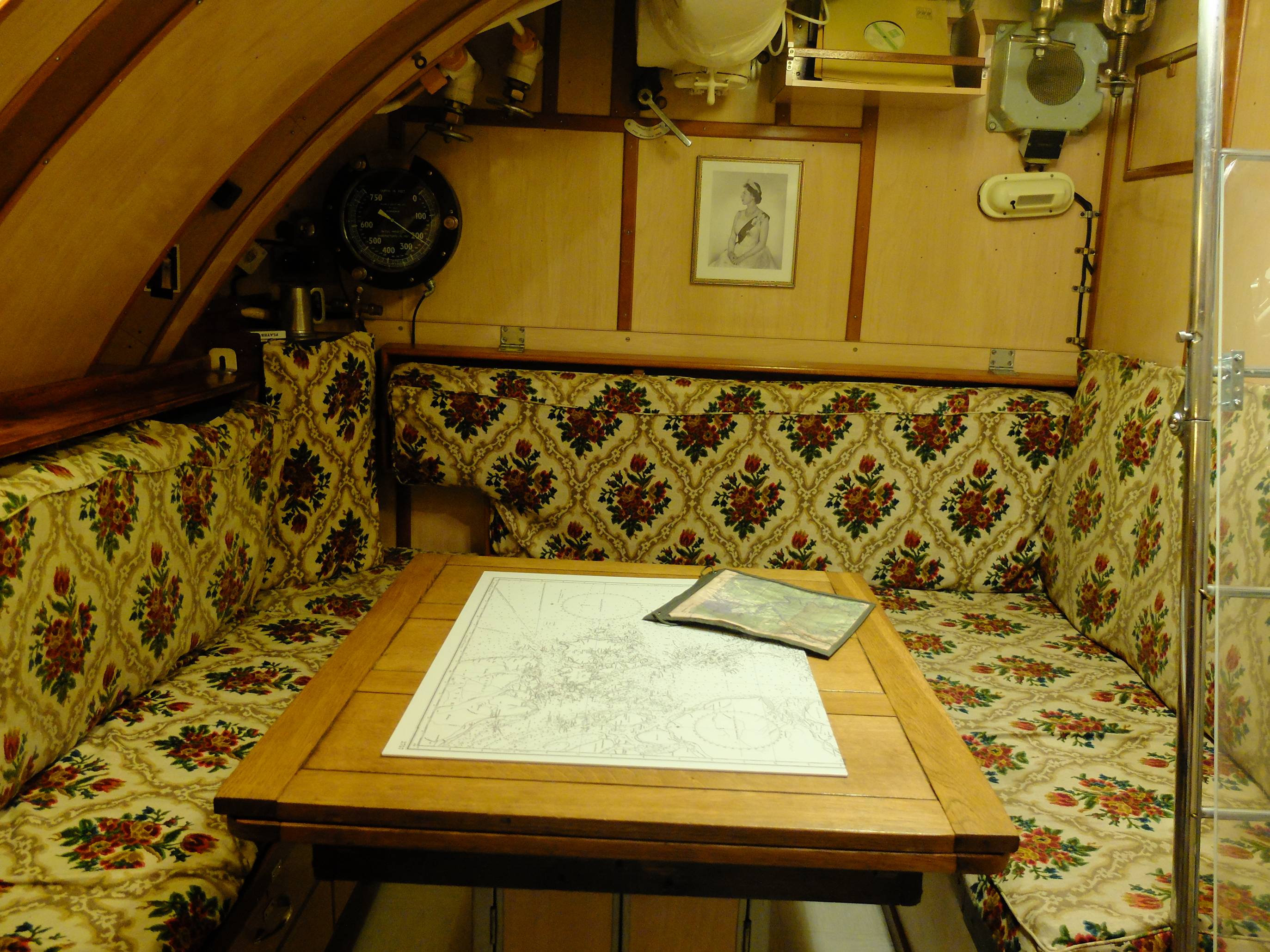
Looking forward on the starboard side, crew bunks line the passage, mess bulkheads are on the left. The TSC is through the door, with the aft tube doors just visible in the distance.
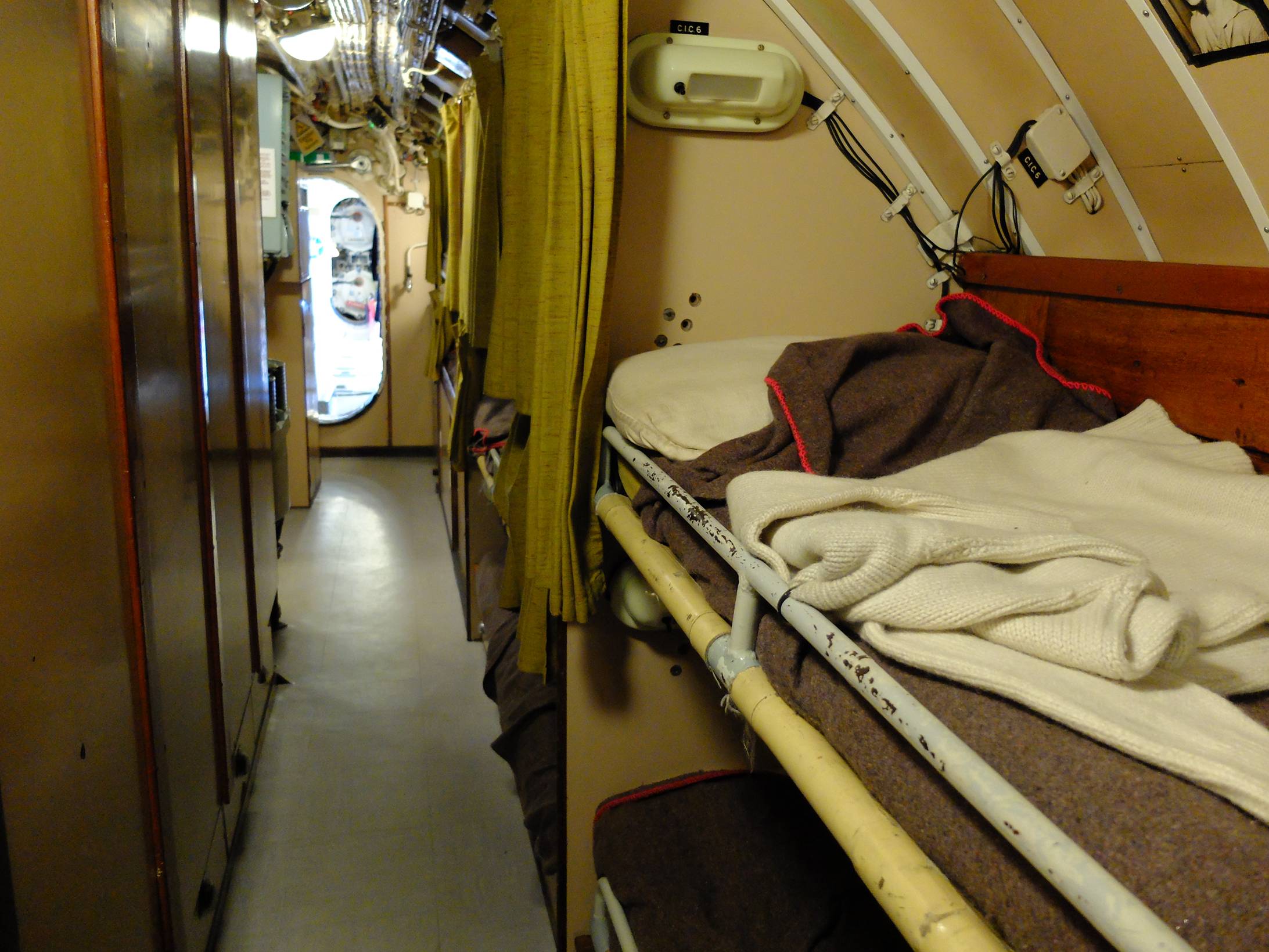
The control room looking forward. The helm position is on the left, with the gyro tape in its horizontal housing.

Aft of the helm are the two planes controls (for and aft). Triumph's wheels have been replaced by handlebars - probably easier to keep visual track of where the planes are when the lights go out.
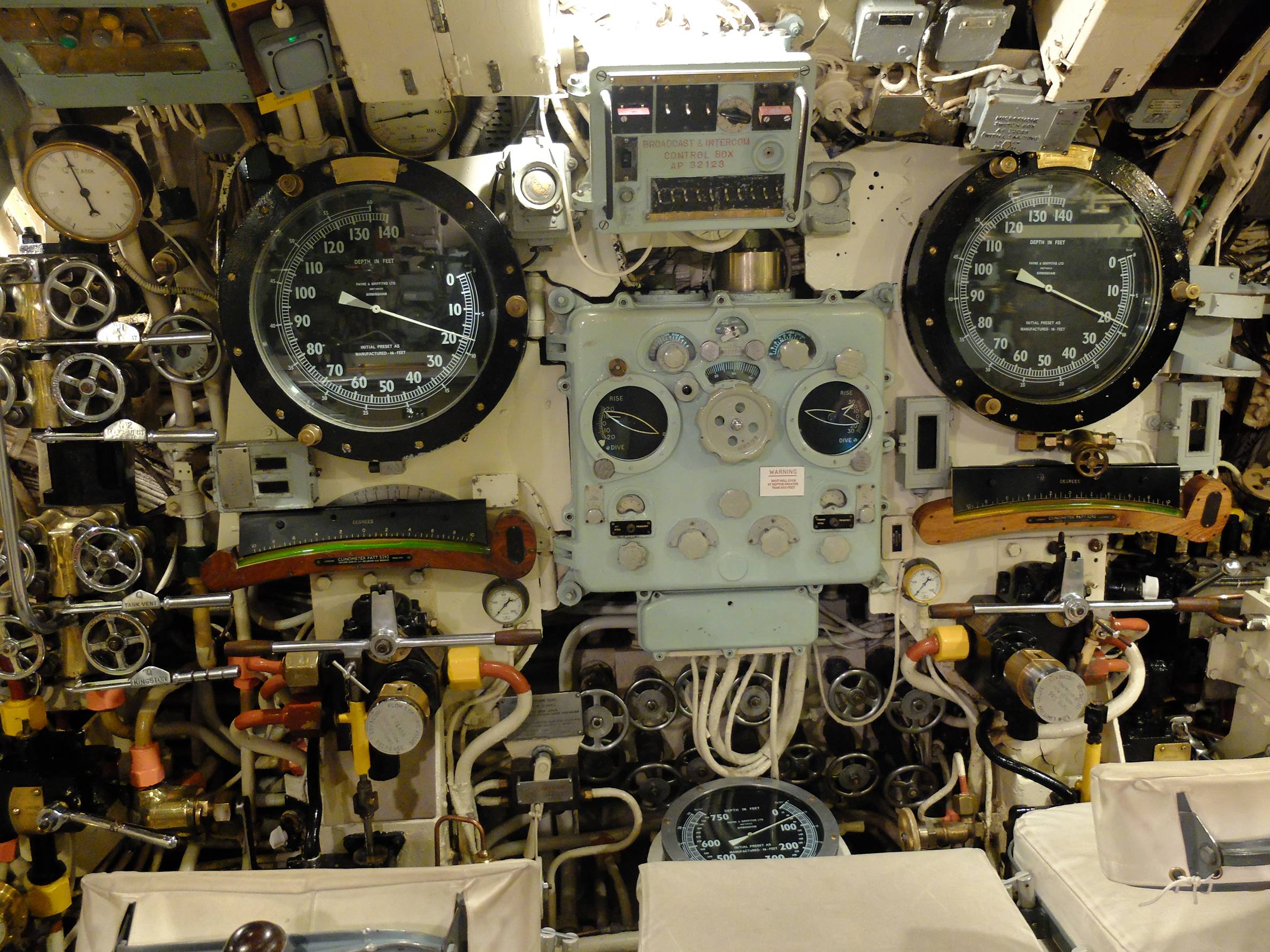
Aft of the planes controls, the blowing panel.
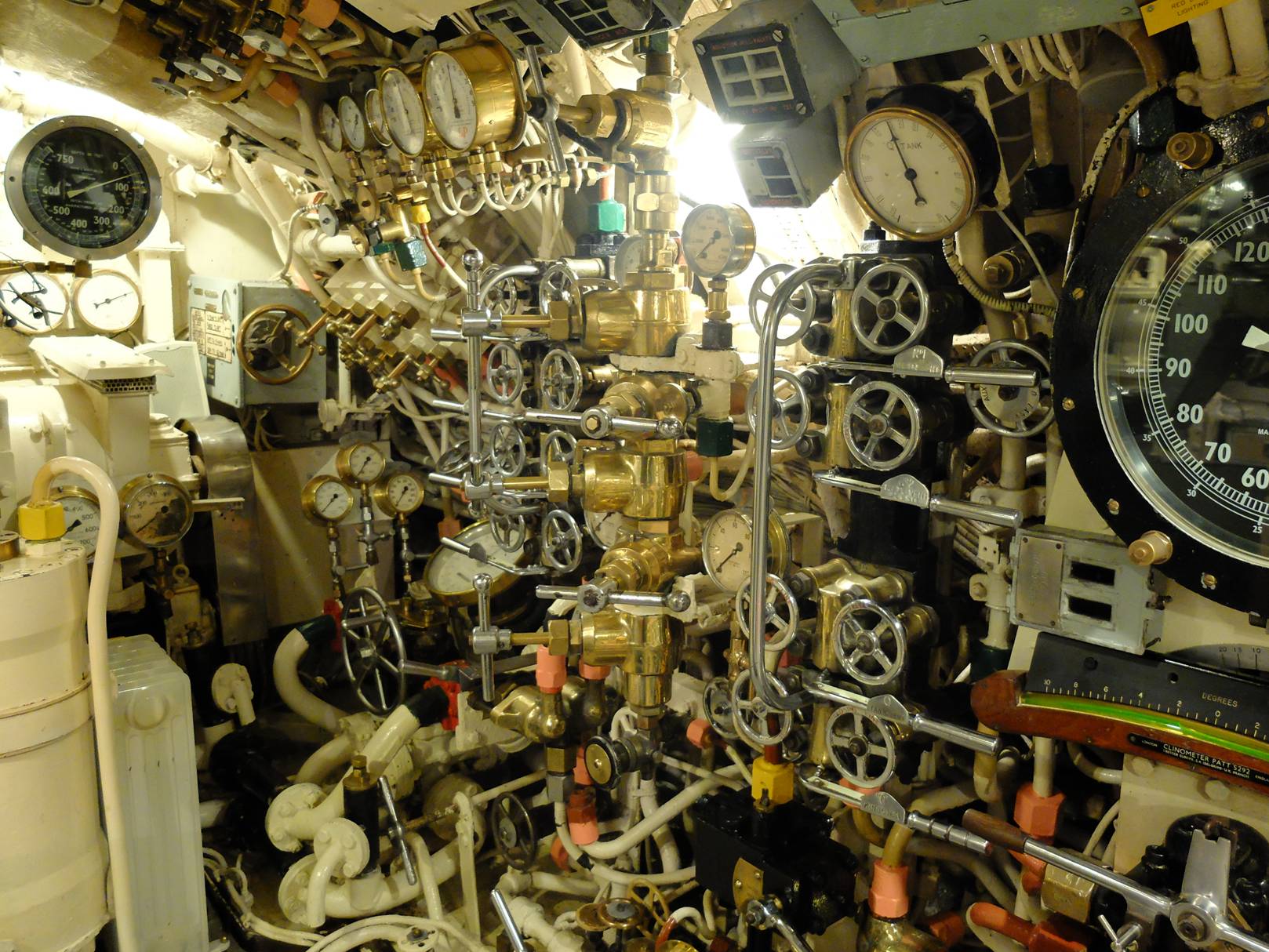
On the starboard side Alliance has a plotting table and radar PPI

The box on the left is the underwater telephone. Above it on the shelf is a hand-held signal lamp, used for flashing recognition signals while surfaced. You can see this in use here

Aft of the control room the Signal Comms Office connected the boat to the outside world.
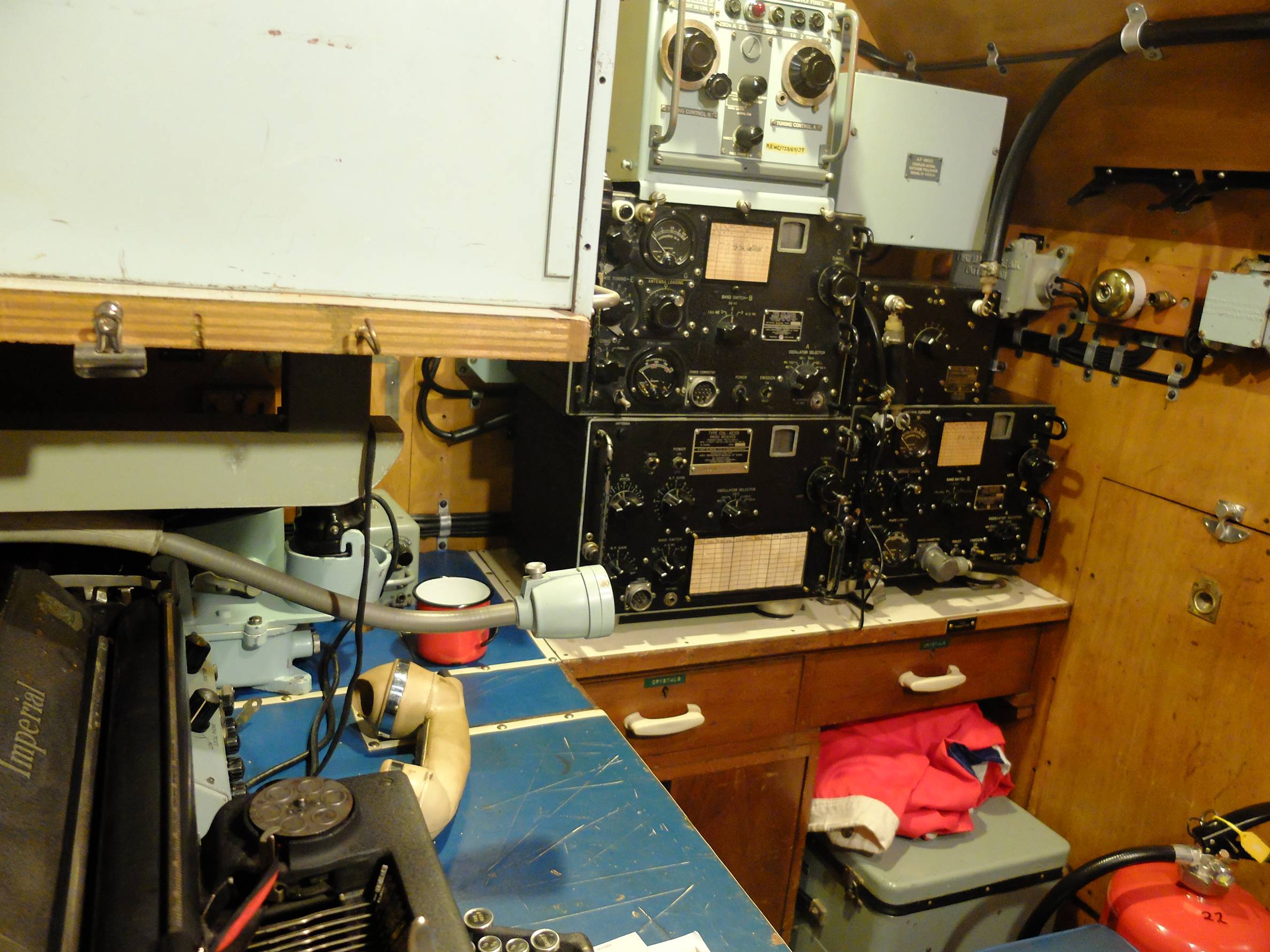
Aft again is the galley. Two chefs fed 60 men three times a day from here.
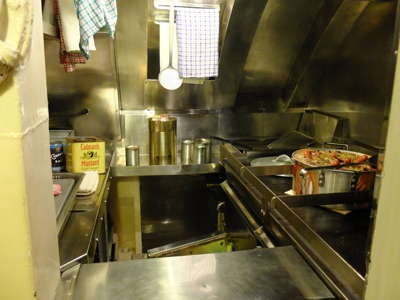
Crew's heads...
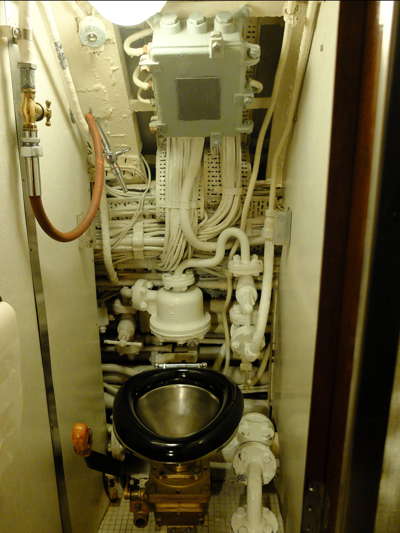
The aft half of the boat is taken up by machinery spaces and the stokers' mess.
At the forrard end of the engine room is the watchkeepers' station, in which sits a lathe. Artificers (highly trained mechanical and electrical engineers) were capable of making all of the equipment under their care from raw metal, and during the war manufactured essential replacement parts on a lathe like this one.
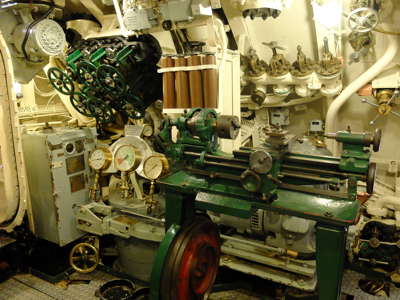
The two main diesel engines. These are at root identical to Triumph's, though with slightly more sophisticated starting mechanisms using compressed air rather than a shotgun cartridge.
The deck plates can be lifted to give access to the crank cases.

One of Alliance's cylinders with the head removed.

At the after end of the machinery space are the two switching panels for controlling current to the electric motors (the motors are below these deck plates). Current was adjusted by setting the batteries to run either in series (grouped down) or in parallel (grouped up). "Down" was for endurance and "up" was for speed. In addition, the large round wheel is a rheostat to make fine adjustments to speed. Alliance had no reversing gearbox for her main engines, so maneouvering in harbour was carried out on electric motors.
In extemis, Alliance's batteries could be grouped to provide 800 volts for maximum dived speed, but only for a matter of minutes before flattening the batteries.
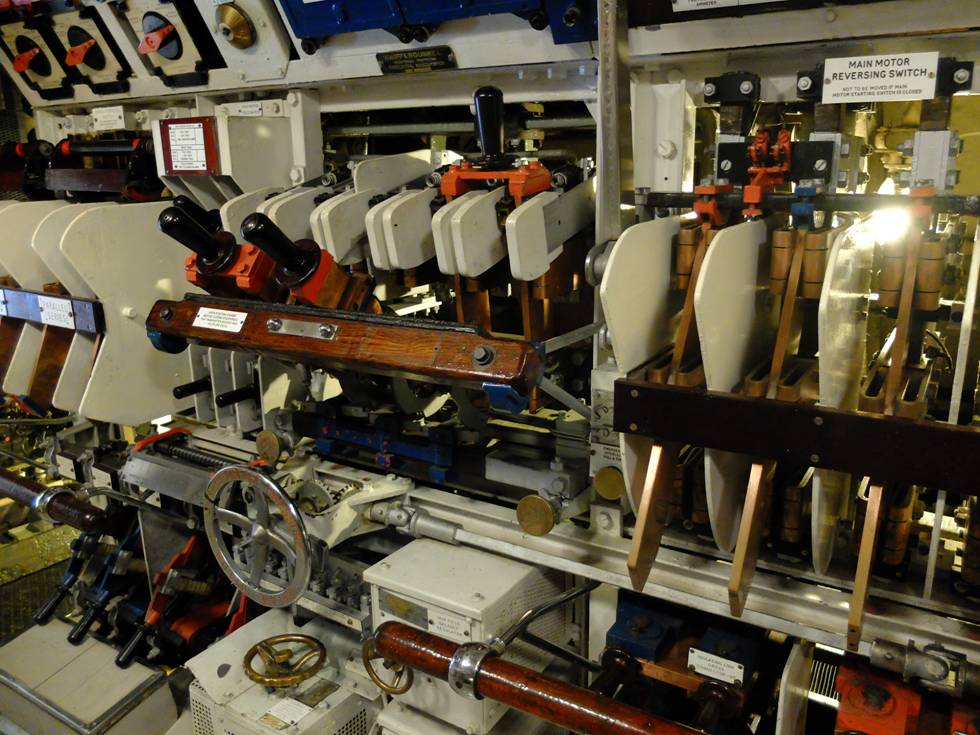
As these ammeters show, the bus bars could carry up to about 1,500 amps.
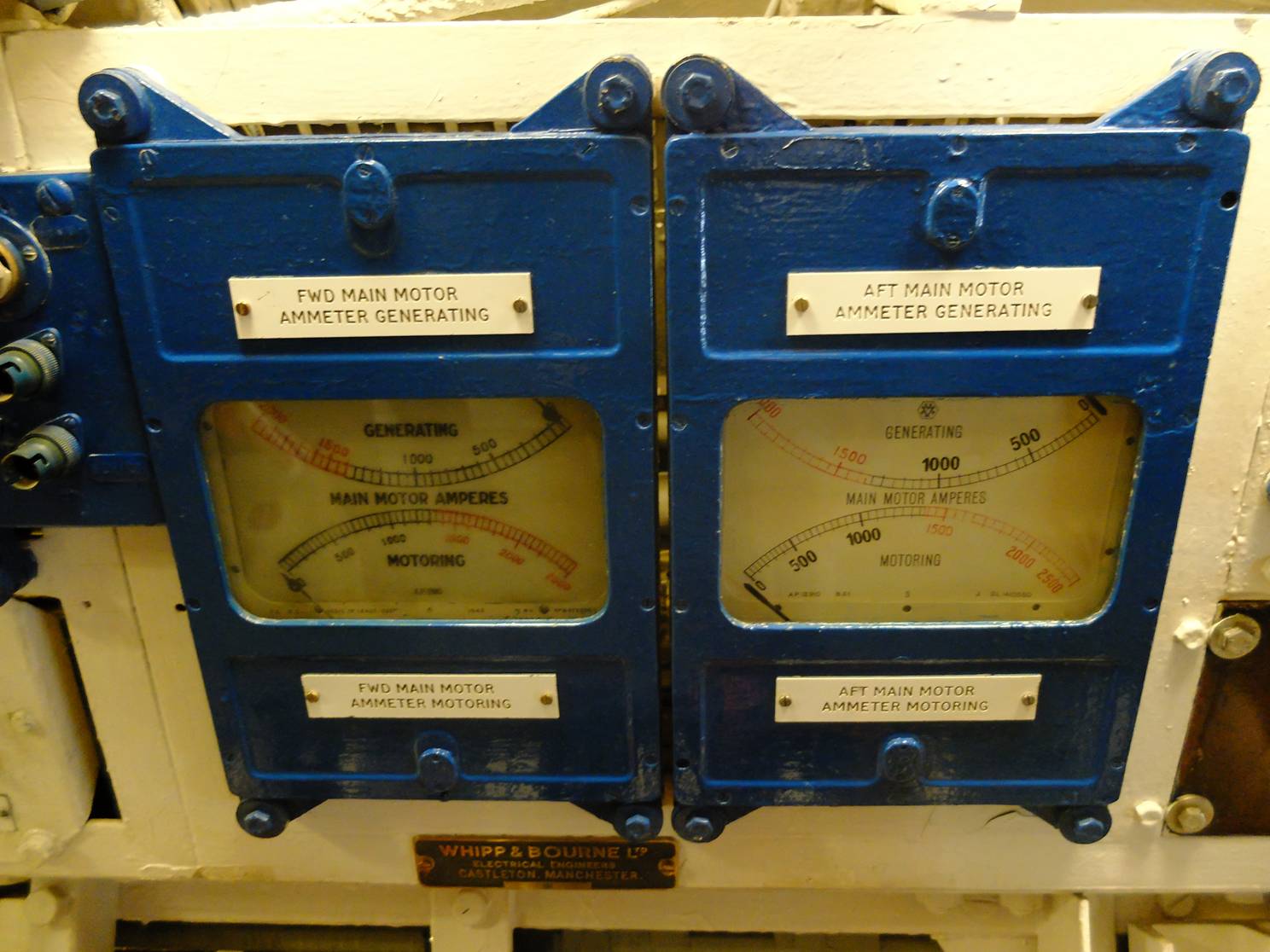
Each main engine was theoretically capable of producing more like 4,000 amps, but that rate of current would have blown the motor windings, the wiring and the batteries, hence the red-lining at about 1,400 amps. Alliance had ample spare power for a combination of propulsion and charging.
Much of Alliance's internal equipment and layout is very similar to a T-boat, and a visit to her will give a very good impression of how Triumph felt to her people.
The submarine museum also has three smaller boats - a salvaged Holland 1, a german Bieber mini-sub, and a Royal Navy X-class midget submarine, HMS X24...

The X-craft were built to attack Tirpitz in Altenfjord (Norway). Xs carried two 4-tonne charges bolted one each side (quite visible in the this picture). The tactic was to dive under the target, unscrew the retaining bolts to drop the charges with timers set, then withdraw. One charge was enough to break a large ship's back if well placed.
Too small to deploy unaided, the Xs were towed to their deployment position behind larger submarines. With almost no reserve of buoyancy and no freeboard this was deeply unpleasant in the North Sea, and one X broke her tow and sank en route.
X24 has been cut in half for display at the SM Museum. Here is her interior looking forward. She has one planesman/helmsman position, on the right of the picture, with rod and gear linkages to her planes and rudder. The small periscope is visible above the planesman's seat, and on either side can be seen the large handles for withdrawing the locking screws for her charges. A rudimentary bunk is on the left.
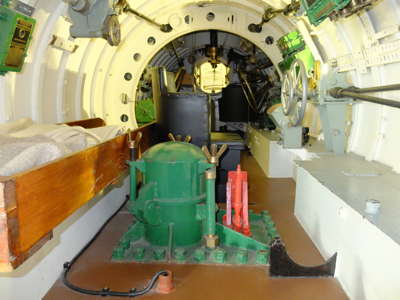
Here is her after end, with her main engine and electric motor. The tall piece of machinery on her starboard side is her compressor

Chatham UK - HMS Ocelot (1962) at the Dockyard in Chatham. The O-class were the RN's workhorse conventional submarines for 30 years. Ocelot is quite similar to Alliance, and is also very reminiscent of how Triumph would have felt.
San Diego CA USA - Russian Foxtrot. The Foxtrot was basically a copy of the last German Uboats. The museum allows a full boat tour, and no internals have been removed. The boat is striking for its lack of clutter, and also for the spartan communist accomodation. The boat is in the San Diego maritime museum, and is well worth a visit.
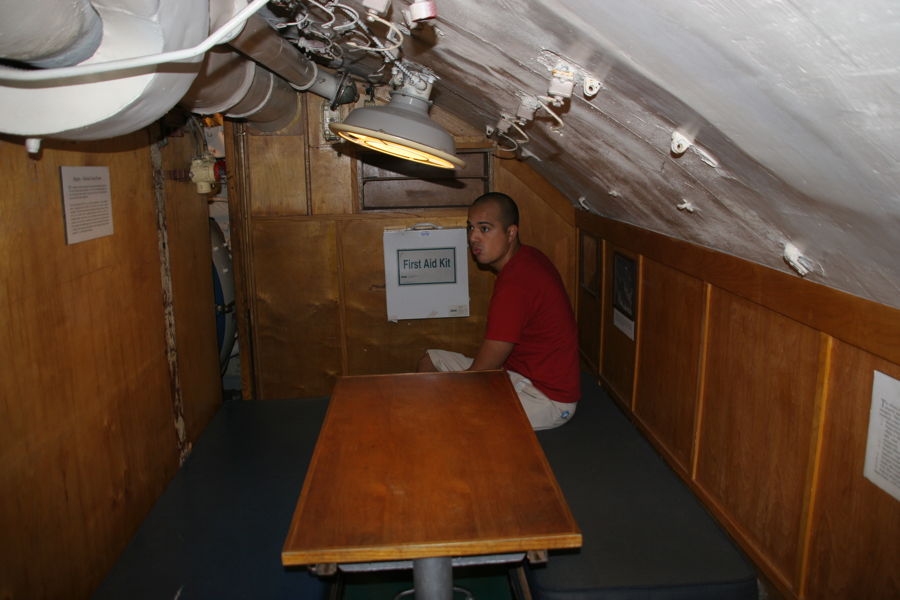
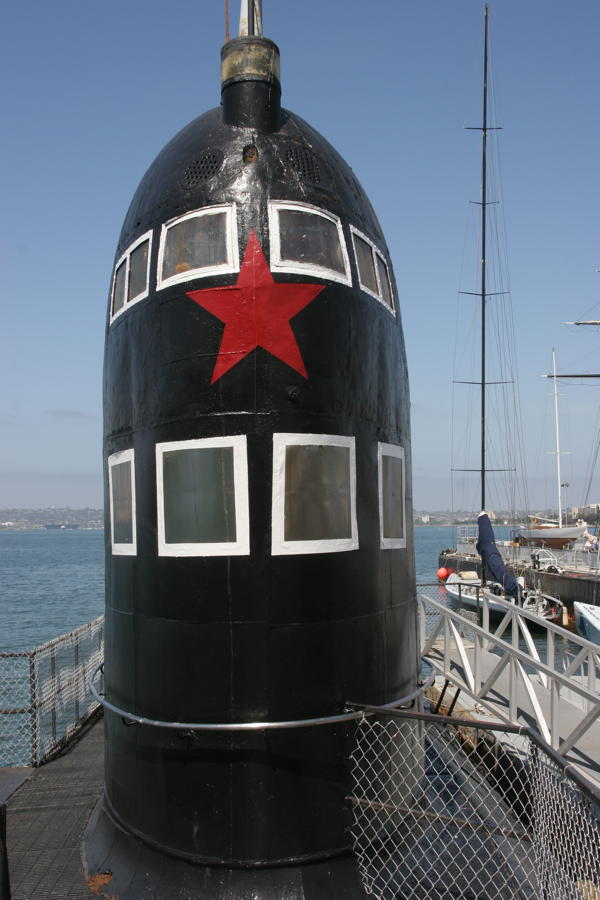
Across the quay from the Foxtrot is USS Dolphin, a deep diving submarine used for ASW practice. Dolphin is still in commission, but is open to the public. She is interesting for her small size and her extremely thick casing - some inches.
Vladivostok, Russia - has an early WW2 boat, up on stocks by the main harbour. Sadly they have removed most of the internal equipment to make space for a submarine exhibition, but a few parts remain. One cannot go onto the casing or onto the fin. This boat is among the oldest submarines on display around the world.

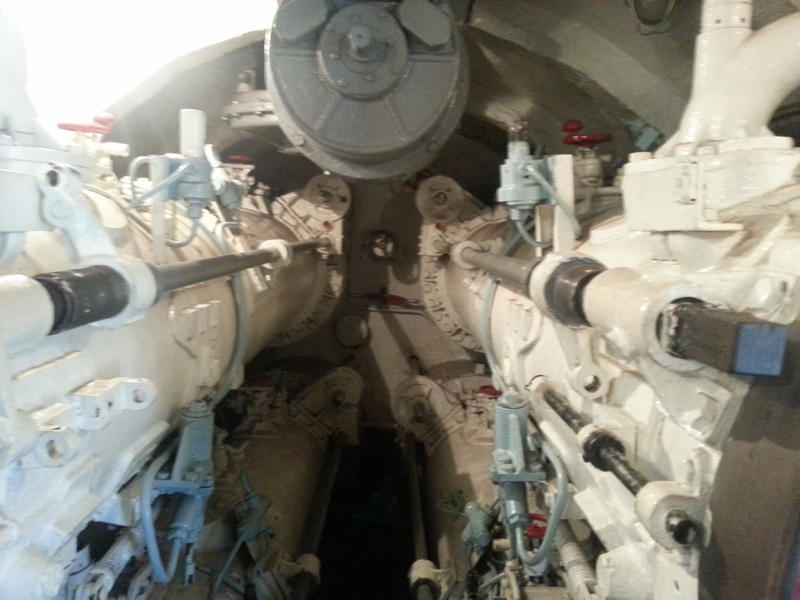
Vladivostok also has a miniature submarine on blocks near this boat, but not open to the public.
Moscow - Tango class SSK - Moscow's canal basin has a retired Tango open to visitors. The forward half of the boat is untouched. A part of the crew's mess has been stripped and turned into a museum, whose most interesting exhibit is a three metre long cutaway builder's model of a Tango. This is a joy, and shows the framing and tankage in perfect detail. Aft of the museum the machinery spaces are almost intact. Again, there is no access to the casing.
Next to the Tango are an assault hovercraft and an Ekranoplan - a surface effect vehicle. Neither are open but both are worth looking at.

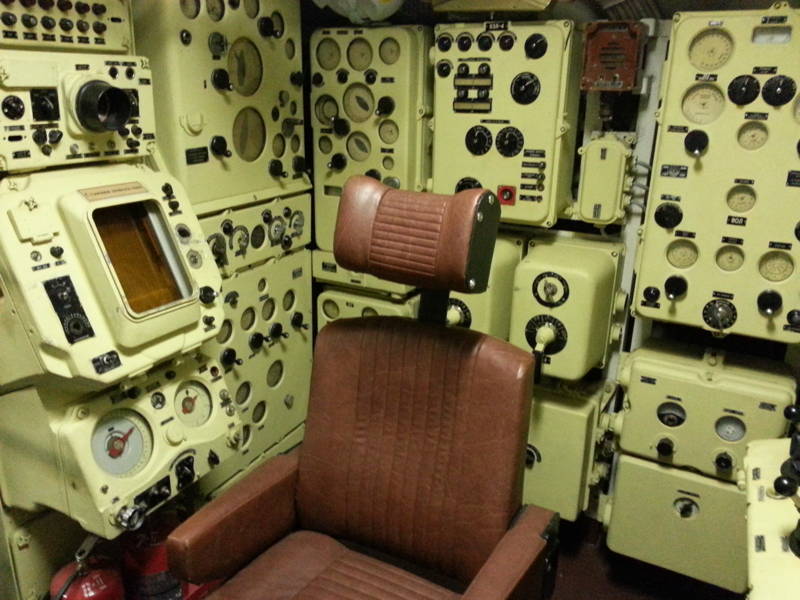

Portland Oregon US SSK Blueback - The US navy's last diesel electric boat, built in a full teardrop configuration. This boat is beautifully presented - all compartments are accessible, and the docents are very informative and helpful.
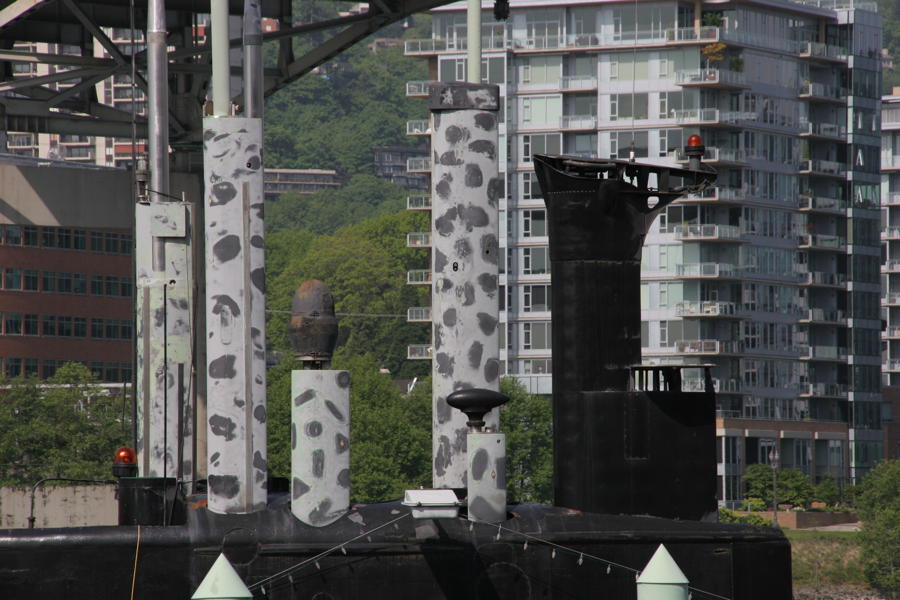
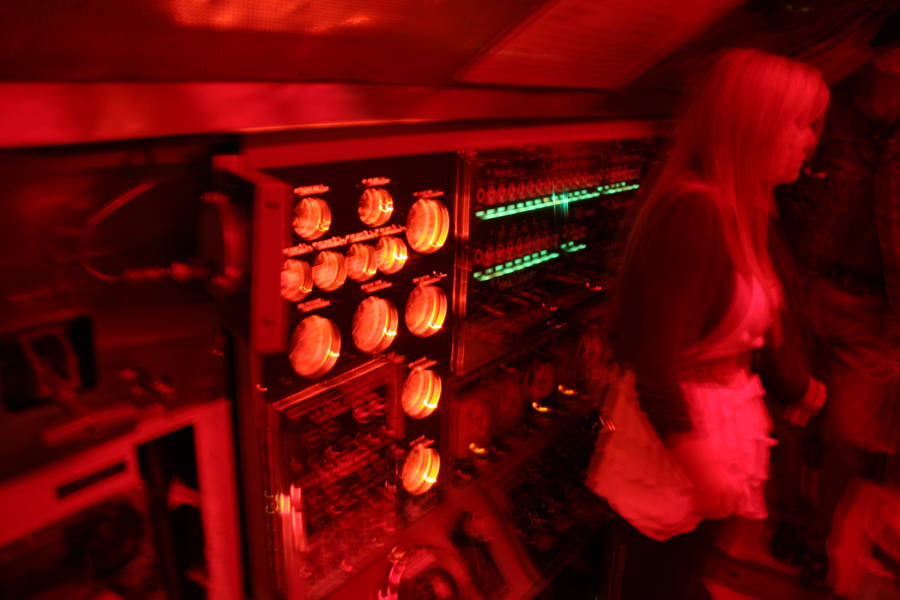
San Francisco - USS Pampanito - A large WW2 diesel electric boat which saw service in the Pacific war, but was mostly a training boat. All compartments are open, and none have been stripped. The Docents are ex submariners and are as interesting as the boat. A striking feature is Pampanito's bows, built high and wide for surface running in big Pacific seas. Accomodation is comfortable, for long patrols in hot weather.

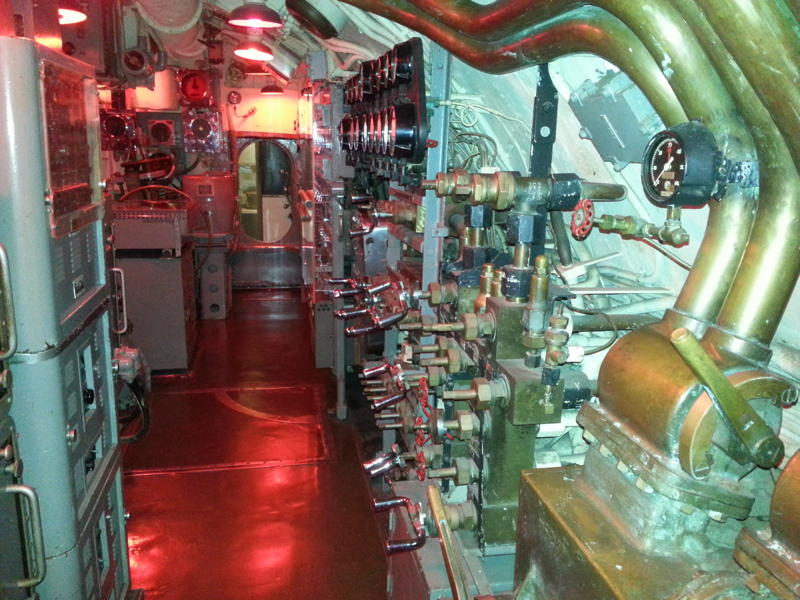
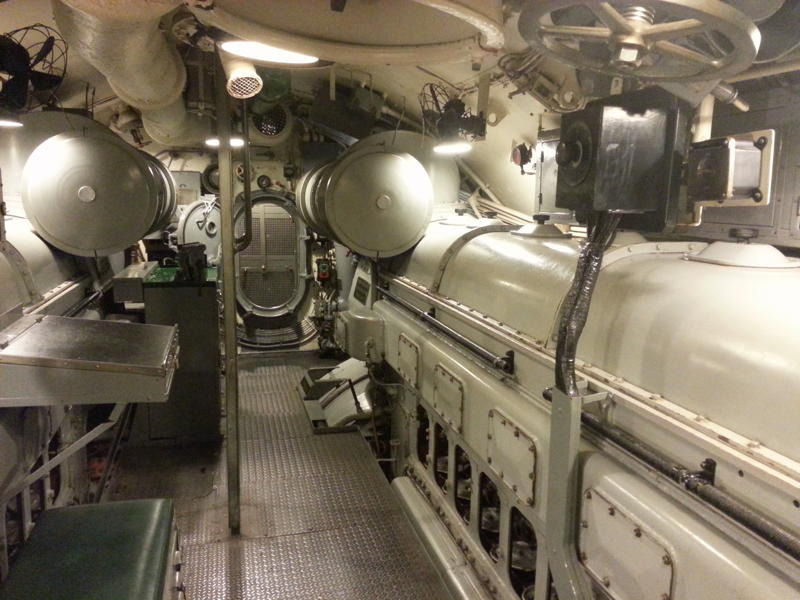
U505 - Chicago Science Museum - The US Navy captured U505 in June 1944 off Africa, and towed her to Bermuda. She is now presented in her own indoor hall at CMSI. She is very well presented - you can walk around and underneath her, and there is a guided tour that enters forward and exits aft. Apart from the hull and fittings cut out to make room for the tour she is pretty much as she would have been at war. The cut-out has removed the wardroom, and the tour doesnt include the upper conning tower.
The tour is quick (probably a bit too quick) but well presented, albeit rather focused on America winning the war single handed. Also, rather naive as to the intelligence value of capturing a boat less than a year before the war ended.
Absolutely a top boat for submarine enthusiasts. You have to buy a timed tour beforehand (I turned up at 0900 and there was only one slot left, so book ahead), and turn up at the exact minute as tours leave every eight minutes. It is not cheap!
The control room:
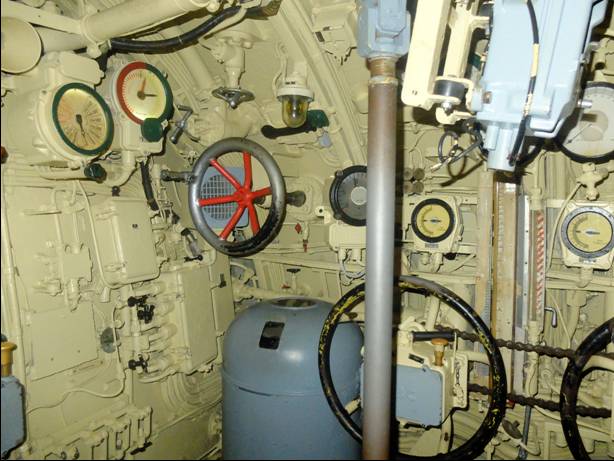
The aft torpedo space:
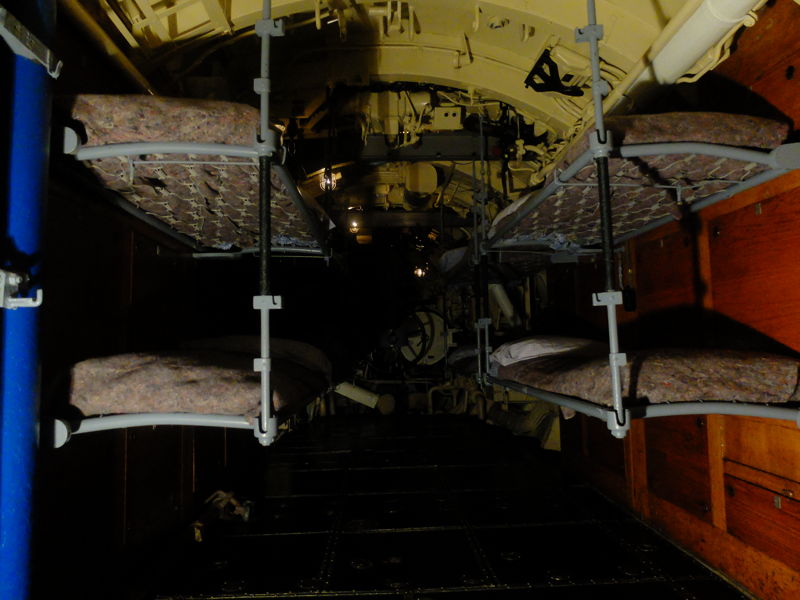
Bow torpedo tube...

Devonport - HMS Courageous
Courageous is a Churchill class SSN which operated in the Royal Navy from 1971 to 1992. Her dived displacement is 4,900 tonnes. Along with all RN SSNs she was retired into a floating berth at HMNB Devonport, and was selected as the RN's museum boat to represent the SSN fleet. She has been extensively refurbished and is presented as if her crew had stepped ashore for a trip to the pub. At present she is berthed inside the security perimeter of the Dockyard, so she can only be visited by special arrangement, but plans are afoot to move her to a more accessible berth for general visiting.

photo from http://www.hmscourageous.co.uk/html/the_boat.html
The tour takes in every part of the boat except the machinery spaces and the fin. However the machinery control panels have been mounted in the old Junior Rates mess. A visit to Courageous is well worth the hassle of getting access.

Looking forward from the galley.
The Torpedo Stowage Compartment, or the "bomb shop" as it is known in the Trade. Courageous had six tubes, 3 across in each row. On the right of the photograph can be seen the cradles for a 21 inch torpedo (or a Tomahawk missile), weighing about the same as a family car. These cradles are powered and could be used to move weapons to any of the six tubes for reload. The ladder in the centre of the compartment is dismountable, and leads up to a large hatch in the bow through which reload torpedoes are taken aboard.
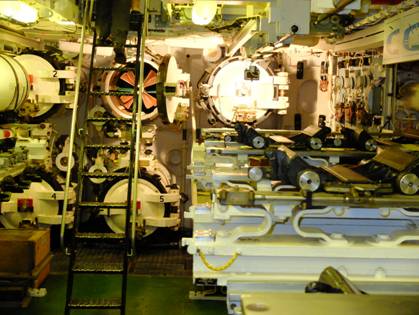
The Bomb Shop served as the submarine's guest accommodation. Visitors, staff or trainees slept on bunks slung above reload torpedoes, usually with a condensation drip of freezing water from the torpedo above to keep them cool. This bunk has also been laid out with three emergency breathing lines. These can be plugged into the boat's emergency oxygen system which is fixed to the deckhead throughout the boat, for use during a fire. To move about the boat using emergency oxygen a man had to take a deep breath, unplug his line from one plug and walk the few steps to the next plug to re-attach himself to the main supply at another plug (hoping that someone else was not already using it).
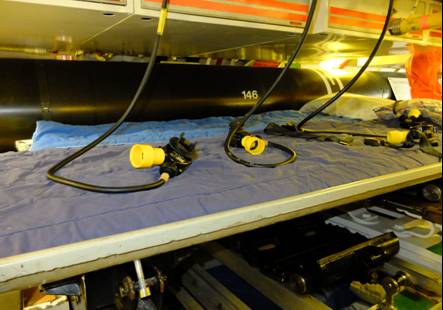
Courageous made her own oxygen by electrolysing sea water. However, if the reactor stopped operating for any reason the crew would start to consume all the available oxygen in the boat. In extreme emergency they could manufacture an additional supply of oxygen using this emergency oxygen (the brass cylinder on the left of the photo). A chemical reaction produces 2,000 litres of oxygen from each generator. A man breathes about 25 litres of oxygen per hour, meaning that one generator would keep the crew alive for about an hour. Courageous carried a stock of these generators. The chemical composition inside is temperamental, and particularly sensitive to contamination with diesel. A few years ago two RN submariners died when an oxygen generator spontaneously combusted due to fuel contamination while their boat was dived under the Arctic ice. Even these days the submarine service is a dangerous occupation.
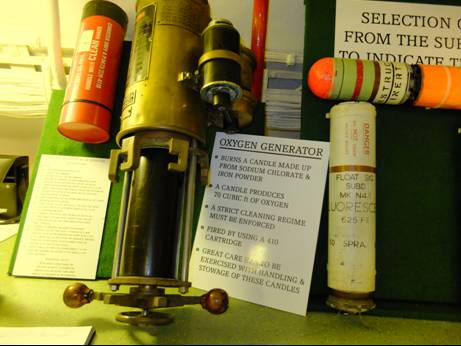
This panel operates the doors of tubes 1, 3 and 5. Each tube has two doors, one to sea and one into the Bomb Shop. Interlocks in the panel prevent both doors being opened at the same time (which would rapidly sink the boat).
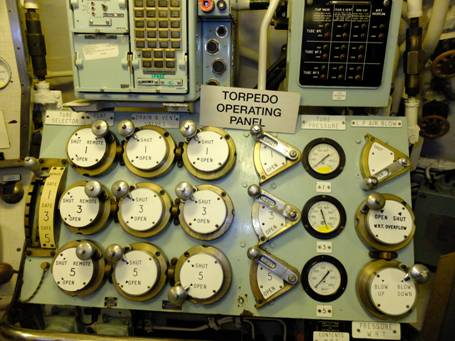
Courageous was built in four watertight sections, with strong bulkheads between each section, to give her a chance of surviving accidental or battle damage received while underwater. These also act as fire and smoke doors. Access between the watertight sections, called compartments, was through doors like this. When shut this door is sealed by rotating the central bar to move the 12 teeth into their seats on the door's frame. The sytem works surprisingly well. At least two nuclear submarines (one USN, one RN) have hit seabed features at speed and survived because of doors like this.
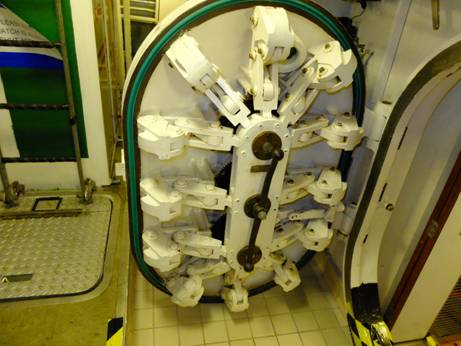
Courageous was a major warship capable of deploying for up to 90 days at a time, and of operating from ports far from her home base. She therefore had to take her administration with her, and the ship's office is where all that paperwork lived. Personnel files, pay records, leave, disciplinary, appraisals, engineering records, food administration, and even on-board summary court proceedings all had their home in this small office.
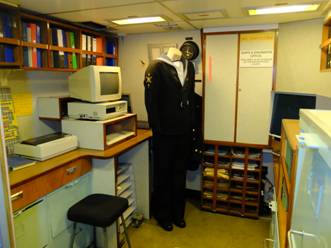
This is the senior rates' mess (the boat's NCOs). 25 men used this as their dining room, office, recreation room, cinema and pub. The barrels wrapped in chintz under the table are spare barrels of CSB - Courage Sparkling Bitter - which was the standard draught beer provided throughout the Fleet. Movies were shown every night on the 16mm projector. About two dozen movies were borrowed from the RN Film Service for each patrol.
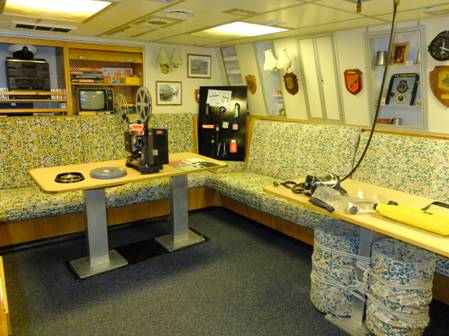
Another view of the same mess, aft end, showing the bar and servery on the right.
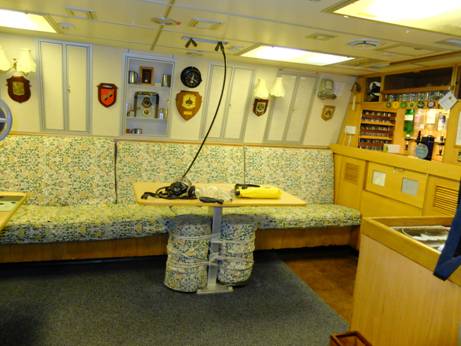
All cooking in the boat was done in one galley, which served three messes - the SRs mess, the Junior Rates Mess, and the Wardroom (the Officers' Mess). The chefs also baked bread daily.

With constraints on cooking space and food storage (most food was stored frozen) menus were limited in variety, but submarine food was nevertheless popular and plentiful. This is a sample menu:
.jpg)
Some translation is needed. BITS are beans in tomato sauce. Spithead pheasant is haddock fillets. Elephant's footprints are spam deep fried in batter. Yellow Peril is kippers. Babies Heads are kidneys. HITS are herrings in tomato sauce.
When on patrol a submarine's invisibility is a strategic asset as well as a tactical one. Once dived an SSN can sail unseen to any part of any ocean on the planet, there to loiter for up to two months with the capacity to sink any surface ship or attack land targets with pinpoint precision up to 1000 kms inland. As such nuclear submarines are major force multipliers - a single submarine punches way above its strategic weight. Secrecy demands that a boat never transmits wireless signals (since these can be detected and reveal her presence). However a boat needs to be able to receive orders and intelligence from her operating authority, so boats are equipped with multiple receivers. The radio and coding equipment live here, in the Comms Office. Courageous could receive VLF (very low frequency) signals while dived using a towed floating aerial, transmitted from the VLF transmitter at Rugby. Signals could also be passed by satellite, though this requires the boat to raise a small dish aerial above the sea surface.
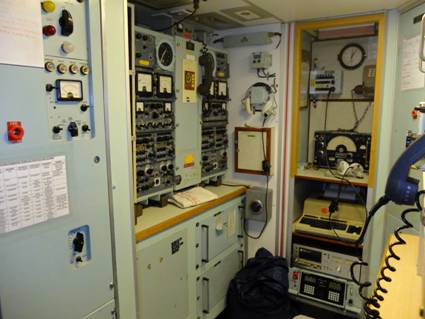
Though Courageous was powered by a nuclear reactor which provided all of the electrical power needed aboard, she also had a set of large lead acid batteries just like a conventional (diesel) submarine. These served two purposes. First they acted as a buffer between the turbo-generators and all the equipment needing power. Second they acted as an emergency power reserve for both equipment and emergency propulsion in case the reactor or the steam plant became unserviceable.

Submariners are not traditionally focused on cleanliness, since the supply of fresh water on a submarine was limited and patrols were comparatively short. With the advent of nuclear power enough spare energy became available to allow regular desalination of sea water aboard the boat while on patrol. At the same time patrol durations rose, and these were only bearable for crews if washing and laundry became possible. As a result Courageous was fitted with a small laundry:

Courageous also has showers and bathrooms for her crew, and men were expected to wash daily.

Submarine operations require a very precise navigational awareness since they often require close approach to a hostile coast, dived transits of narrow channels and straits, exact rendezvous points for special operations, and accurate position data for the launch of land attack missiles. Satellites give accurate positions but only if the boat raises a receiver above the surface, which can of course be detected. The solution to covert navigation is this machine - the Ship's Inertial Navigation System, or SINS. SINS used sensitive accelerometers to detect every movement of the boat in three dimensions. These were then summed to give an accurate track and so an accurate position while dived.

Other boats I havent visited yet...
O boats:
Valdivia Chile - O'Brien
Sydney - HMAS Onslow
Holbrook Aus - HMAS Otway
Fremantle Aus - HMAS Ovens
Rio - Riachuelo Oberon Class
Quebec - Onondaga O class
Port Burwell Ontario - HMCS Ojibwa O class
Sassnitz - HMS Otus
X Boats:
Helensburgh - X51 at the Scottish Submarine Centre (not to be confused with the Maritime Museum at Denny Tank). X51 is displayed suspended 2 metres off the ground, and the museum is creating a an audio visual display which will project internal views onto her hull.
Gosport - X24 at the RN SM Museum
Aberlady Bay - the remains of two boats can be seen at low water springs
Russian boats:
Zeebrugge - Foxtrot class
Tallin - Kalev class
Hamburg - Tango Class
Surabaya - Soviet Whiskey 1952
St Petersburg - Narodvolets 1994
St Petersburg - S189
Togliatti - Tango class
Kaliningrad - Foxtrot class
Vytegra - Foxtrot class
Long Beach - Foxtrot class
Providence Rhode Island - Soviet Juliett class
Krasnodar - Quebec class
European boats:
Helsinki - Vessiko
Marseille - Naiad class 1904
Paris - Argonaute 1959
Saint Nazaire - Espadon 1958
Lorient - Flore 1961
Milan - Enrico Toti 1967
Lisbon - Barracuda, in service 1968-2010
The Daphne class boat Barracuda is in dry dock in Lisbon (across the Tagus from the main city, a short ferry-ride), and is being slowly restored for opening as a museum boat.
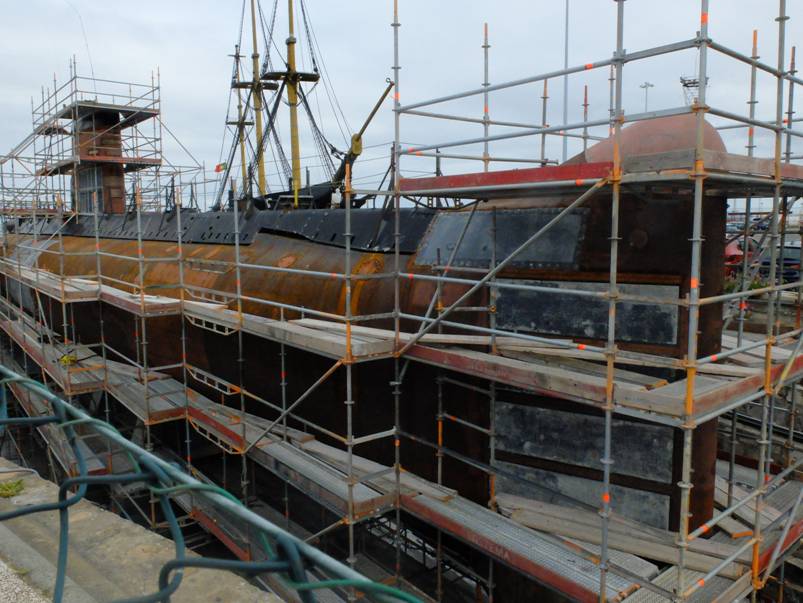
warshipsresearch.blogspot.com/2018/12/portuguese-diesel-electric-submarine_30.html
and there is a video of the internals of her sister Dolphin here...
Genoa - Sauro 1976
Karlskrona - Naeken 1980
Gotteberg - Draken 1962
Karachi - Daphne class 1970
Haifa - Gal 1975
Den Helder - Potvis 1965
Copenhagen - Seal - a modern boat, but almost never open. We requested a visit to take some photographs for this page but the museum refused. You can book a private tour but it costs a lot.
Cherbourg - SSBN
Tallin - Lembit, built at Vickers Armstrong
Uboats:
Munich - U1
Laboe - U995
Bremerhaven - U 2540
Speyer - U9 1960
Fehmarn - U11
Peenemunde - U461
Wilhelmshaven - U10 1960
Channakale - UB46
Birkenhead - U534 (in pieces)
Malmo - U3 1942
Chicago Institute of Tech - U505, captured intact in 1943, and presented indoors in pristine condition. Guided tours only, you have to buy a timed ticket in advance.
Japanese boats:
Visakhapatnam - Kursura 1969
Kure - Yushe 1985
Groton CT - Japanese Type A midget
Fredericksburg Tx - Japanese Type A midget
Etajima - Type A midget 1940
Guam - Japanese MIdget submarine
North Korean boat:
Gangneung - Sang -O class (Shark class)
This North Korean boat was captured by South Korea after running aground in 1996.
US Boats:
Istanbul - ex USS Thornback
Charleston - CSS Hunley
Paterson NJ - the Fenian Ram
John Holland was an Irish schoolteacher. Born in 1840 he emigrated to the USA in 1873. While teaching in Ireland Holland had studied the battle between the Monitor and Merrimac during the American civil war, and concluded that ironclads could best be sunk by an attack from below. In New Jersey Holland began to design a submarine, funded by the Irish Fenian Brotherhood. His first design was one man-operated vessel and was a 2.5 tonne boat. The brotherhood were sufficiently impresses to fund another design - nicknamed the Fenian Ram, which was launched in 1881.
This displaced 19 tons. The Fenians disliked Holland's costs and took possession of the boat, but without Holland they took the project no further. This is one of the boats in Paterson NJ.
Holland went on to take his design to the US Navy, and in 1893 won a design contest for a new boat run by the Navy - Plunger, 84 feet long and 12 feet in diameter with a displacement of 168 tons.
Holland began a private venture at his Torpedo Boat Company (later Electric Boat), taking up his old design for the Ram. His new boat was 52 feet long with a displacement of 75 tons. In 1900 the US Navy scrapped Plunger and commissioned USS Holland.
Groton CT - USS Nautilus SSN
Hackensack NJ - USS Ling
Galveston TX - USS Cavalla
Buffalo NY - USS Croaker
Portsmouth NH - USS Albacore
Muskogee OK - USS Batfish
Philadelphia PA - USS Becuna
Honolulu - USS Bowfin
Karlskrona Sweden - Holland 1904
(more to come...)
Orkney
Mike Ilett, an ex RN submariner, has created a unique submarine museum at his house on Orkney (Eday, to be precise). He has mounted salvaged equipment from HMS Otter, HMS Artemis, and a few others, and is happy to receive boarders:

Below: the valve gear came out of Artemis.

The motor room:
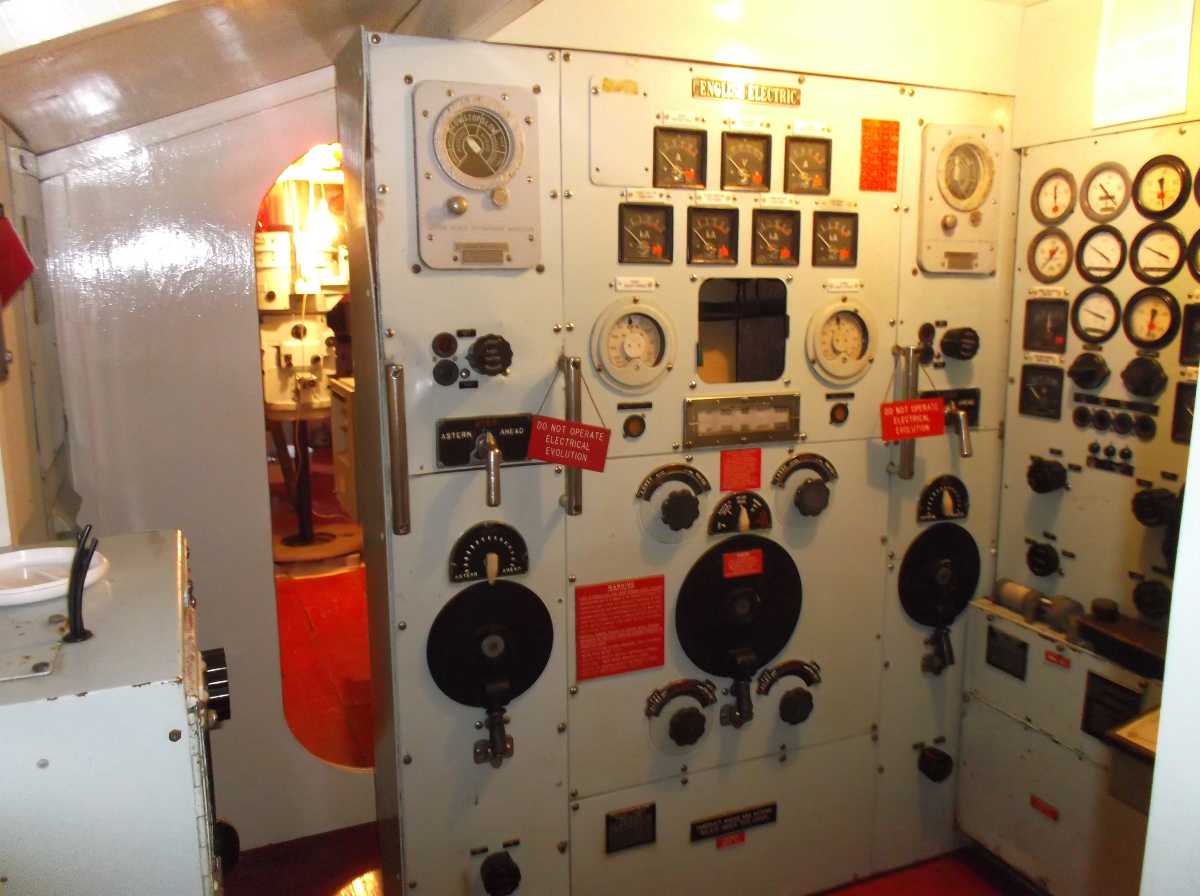
The charging panel:

A passageway:

